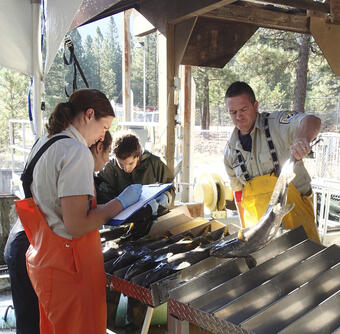Diseases of Aquatic Organisms
Scientific expertise in aquatic animal health within the USGS spans over eight science centers across the nation, with researchers working on all aspects of aquatic animal diseases.
Healthy aquatic ecosystems are home to a diversity of plants, invertebrates, fish and wildlife. Aquatic animal populations face unprecedented threats to their health and survival from climate change, water shortages, habitat alteration, invasive species and environmental contaminants. These environmental stressors can directly impact the prevalence and severity of disease in aquatic populations. For example, periodic fish kills in the upper Chesapeake Bay Watershed are associated with many different opportunistic pathogens that proliferate in stressed fish populations. An estimated 80 percent of endangered juvenile Puget Sound steelhead trout die within two weeks of entering the marine environment, and a role for disease in these losses is being investigated. The introduction of viral hemorrhagic septicemia virus (VHSV) into the Great Lakes—a fishery worth an estimated 7 billion dollars annually—resulted in widespread fish die-offs and virus detections in 28 different fish species. Millions of dying sea stars along the west coast of North America have led to investigations into sea star wasting disease. U.S. Geological Survey (USGS) scientists are assisting managers with these issues through ecological investigations of aquatic animal diseases, field surveillance, and research to promote the development of mitigation strategies.
USGS research supports the needs of regulatory agencies including U.S. Fish and Wildlife Service, National Park Service, U.S. Department of Agriculture, Bureau of Reclamation, National Oceanic and Atmospheric Administration (NOAA), and numerous local, State, and Tribal agencies. USGSscientists support these organizations through a diverse research portfolio that often begins with on-the-ground disease surveillance, investigation of aquatic animal die-offs, and diagnostic support. Field investigations often lead to laboratory studies to identify cause of disease, evaluate risk factors, and develop disease detection and mitigation tools. Results from field and laboratory studies can be integrated into epidemiological models to understand disease transmission rates and population level disease impacts. The goal of USGS research is to identify science-based solutions that can restore aquatic ecosystems to favorable health and mitigate disease risks. Our science promotes global efforts to protect the aquatic ecosystems that connect continents.




